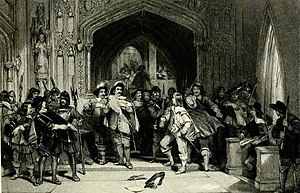Pride's Purge
| Pride’s Purge | |
|---|---|
| Part of Second English Civil War | |
 Colonel Pride refusing admission to the Presbyterian members of the Long Parliament. (Engraving, c. 1652) |
|
| Planned by | The Grandees of the New Model Army |
| Objective | Forcibly remove from the Long Parliament all those who were not supporters of the Grandees in the New Model Army and the Independents. |
| Date | 6 December 1648 |
| Outcome | Establishment of the Rump Parliament |
Pride’s Purge was an event that took place in December 1648, during the Second English Civil War, when troops of the New Model Army under the command of Colonel Thomas Pride forcibly removed from the Long Parliament all those who were not supporters of the Grandees in the New Model Army and the Independents. Some have called it a coup d'état.
In 1648, King Charles I was in captivity at Carisbrooke Castle and the first stage of the English Civil War was over. The Long Parliament issued a set of demands for the future government of the Kingdom and sent commissioners to negotiate with the King over the terms of the putative Treaty of Newport. The leaders of the New Model Army had previously tried to negotiate with the King themselves in 1647, shortly after the end of the first civil war in 1646. Its leaders, the "grandees", were sorely disappointed when Charles stalled these negotiations by quite clearly attempting to play different factions in the Parliamentary alliance off against others. He eventually escaped captivity, leading to the second civil war that raged between 1647 and 1649. By the time Charles was recaptured, most of the army leaders were convinced that they could no longer trust him. So the army sent in a remonstrance on 20 November 1648, which was rejected by 125 votes to 58 in the House of Commons on 1 December. When the Commissioners returned with the King's answers, which were far short of what was hoped, the House of Commons eventually declared them acceptable by 129 votes to 83 early in the morning of 5 December 1648 (though this was technically a vote on whether the vote should be called).
On Wednesday 6 December Colonel Pride’s Regiment of Foot took up position on the stairs leading to the House, while Nathaniel Rich’s Regiment of Horse provided backup. Pride himself stood at the top of the stairs. As MPs arrived, he checked them against the list provided to him; Lord Grey of Groby helped to identify those to be arrested and those to be prevented from entering. The purge was not over in one day, and a military watch was kept on the entrance until 12 December. By then 45 members had been imprisoned of which 25 were released before Christmas. It is not known exactly how many were excluded as many, once they heard of the purge, voluntarily stayed away, either because they feared they would be arrested but more usually as a sign of protest. Pre-purge the number of members who were still eligible to sit in the house was 507 but 18 seats were vacant and a further 18 members had not sat for a long time which meant that there were 471 active members. After the purge just over 200 members sat in what would become known as the Rump Parliament. Of the 200, 86 absented themselves voluntarily, 83 were allowed back in Parliament after formally dissenting from the decision to accept the King's proposals, and 71 were supporters of the army from the outset (see List of MPs not excluded from the English parliament in 1648).
...
Wikipedia
